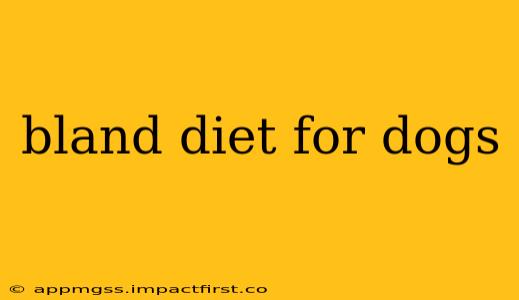A bland diet for dogs is often recommended by veterinarians to soothe upset stomachs and aid in the healing process of various digestive issues. This specialized diet consists of easily digestible ingredients, minimizing the strain on a dog's sensitive gastrointestinal tract. However, it's crucial to understand when a bland diet is appropriate, how to prepare it correctly, and when to seek professional veterinary advice. This comprehensive guide will delve into all these aspects, helping you understand how to best care for your canine companion.
What is a Bland Diet for Dogs?
A bland diet typically involves simple, easily digestible ingredients like boiled chicken breast (skinless and boneless) and plain, white rice. These foods are low in fat, fiber, and additives, reducing the likelihood of further irritating the digestive system. The goal is to provide easily absorbable nutrients while allowing the gut to rest and heal. This diet is not intended as a long-term nutritional solution, but rather a temporary measure to address specific digestive problems.
When Should You Feed Your Dog a Bland Diet?
Veterinarians may recommend a bland diet for various reasons, including:
- Acute diarrhea: A sudden onset of diarrhea can often be addressed with a bland diet to help firm up stools and reduce irritation.
- Vomiting: If your dog is vomiting frequently, a bland diet can help settle their stomach and prevent further dehydration.
- Food sensitivities: In some cases, a bland diet can help determine if your dog has a food allergy or intolerance by eliminating potential triggers. This should be done under veterinary supervision.
- Gastrointestinal inflammation: Conditions like inflammatory bowel disease (IBD) may benefit from a temporary period of bland food to reduce inflammation.
- Post-surgery: A bland diet can be gentle on the digestive system after surgery, allowing for proper healing.
It's crucial to note: A bland diet should always be introduced under the guidance of a veterinarian. They can diagnose the underlying cause of your dog's digestive upset and determine the appropriate duration of the bland diet.
What Foods Are Included in a Bland Diet for Dogs?
The core components of a typical bland diet are:
- Boiled chicken breast: Provides easily digestible protein. Ensure all bones and skin are removed.
- Plain white rice: A source of easily digestible carbohydrates. Avoid brown rice, as it's higher in fiber.
Some veterinarians might also add:
- Plain cooked oatmeal: Can provide additional fiber in moderation, depending on your dog's specific needs. Ensure it's plain, without any added sugars or flavorings.
- Plain, unsweetened applesauce (in small amounts): Can add some pectin, which can help firm up stools.
Foods to Absolutely Avoid:
- Fatty foods: These can worsen digestive upset.
- Spicy foods: Can further irritate the gastrointestinal tract.
- Dairy products: Many dogs are lactose intolerant.
- Processed foods: These often contain artificial ingredients and additives that should be avoided.
- Bones: Can cause choking hazards and digestive problems.
- High-fiber foods: Can worsen diarrhea.
How Long Should My Dog Be on a Bland Diet?
The duration of a bland diet varies greatly depending on the underlying condition and your dog's response to the diet. It could range from a few days to a couple of weeks. Your veterinarian will provide guidance on the appropriate duration and when to transition back to a regular diet. Gradually reintroducing their regular food is essential to prevent further digestive upset.
What if My Dog's Symptoms Don't Improve?
If your dog's symptoms persist or worsen despite being on a bland diet, it's imperative to seek immediate veterinary attention. There may be an underlying medical condition requiring further diagnosis and treatment. Do not attempt to self-treat your dog.
Can I Make My Own Bland Diet or Buy Pre-Made Options?
You can certainly prepare a bland diet at home, following the guidelines above. However, commercially available bland diets are also available, ensuring a balanced nutrient profile. Discuss the best option with your veterinarian.
My Dog Won't Eat the Bland Diet. What Should I Do?
Some dogs may be hesitant to eat the bland diet due to its lack of flavor. Try warming it slightly to enhance the aroma, or mixing in a small amount of low-sodium broth (chicken or beef) to make it more palatable. However, do not force your dog to eat. If they consistently refuse the bland diet, consult your veterinarian.
This guide provides general information on bland diets for dogs. Always consult your veterinarian for personalized advice tailored to your dog's specific needs and health condition. Ignoring veterinary guidance can have serious consequences for your pet's health.
